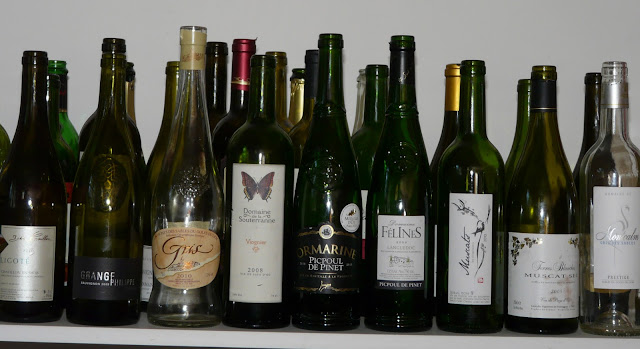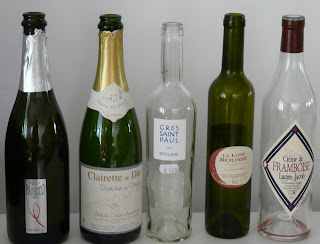This being a birthday month there are some specially good bottles among this lot. Our September tasting circle included 4 Chambolle Musignys and two village reds from the Côte de Nuits, of which only the 2007 C-M disappointed - not such a good year, perhaps too young.
Among the whites and rosés, a new discovery - the Dom. de Fadèze near Marseillan and the Etang de Thau - stands out for its refereshing rosés. Another wonderful rosé from the Chemin des Rêves - see also below, and (from Bourgne) alongside 3 aligotés which drank well despite their age, but made excellent kirs too, there was a Ch des Hospitaliers 'Muscats' (4 different varieites of muscat grape).
In reds, apart from the tasting, we had some excellent wines. Apart from non-French wines from Chile and Italy (the Lascar Carmenere was lovely, and the Montepluciano d'Abruzzo a good cheap standby from Lidl) you'll see Abracadra from the Chemin des Rêves again, a syrah
vin de pays from the Salle de Gour domaine at St Hippolyte du Fort (which I am amazed to say is now on sale at our bakers'!!), an Enclave des Papes we found at the
cave coopérative in Visan and one of the sensations of the fortnight, a 2000 Vacqueyras from the Domaine des Amouriers. This was one of our first discoveries in the southern Rhône, and is still winning accolades after reviving after the unexpected death of its Polish owner in the late 90s.
Finally we have a variety of sweet wines, apéritis and alcohols used for kir and other mixtures and cocktails. Highlights are the
crème de cassis from Bourgogne and
limoncello from Italy, both used to make kinds of kir with aligoté whites, and the sweet wines made from late-picked grapes - the '15 novembre' from Didier Cornillon in the Drôme, and the muscat
vendanges tardives from the local
cave coopérativeat Vérargues - simply delicious!



































